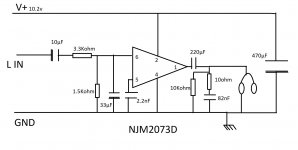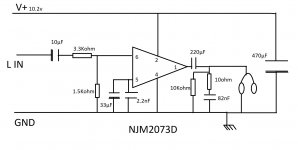Hi!
I got a Yamaha MT1X 4 track tape recorder and I'm getting a lot of hiss through the headphones. It is there whether I have a signal or not, independent of volume and it doesn't change when I unplug the input of the headphone amp circuit.
Here's a quickly drawn layout of the circuit around a NJM2073D (already replaced) : (Sorry for my pour skills on Paint).
(Sorry for my pour skills on Paint).
I did just one but its a stereo circuit and the hiss is present on both channels. The resistors are within tolerance and output caps were replaced because they were leaking badly.
The output to the headphones gets loud very quickly, could there be a gain problem with this design ?
I got a Yamaha MT1X 4 track tape recorder and I'm getting a lot of hiss through the headphones. It is there whether I have a signal or not, independent of volume and it doesn't change when I unplug the input of the headphone amp circuit.
Here's a quickly drawn layout of the circuit around a NJM2073D (already replaced) :
 (Sorry for my pour skills on Paint).
(Sorry for my pour skills on Paint).I did just one but its a stereo circuit and the hiss is present on both channels. The resistors are within tolerance and output caps were replaced because they were leaking badly.
The output to the headphones gets loud very quickly, could there be a gain problem with this design ?
There is a potential problem, yes.
The NJM2073 is a small power amp designed to drive a speaker. Connecting headphones directly to the output of any such amp will allow any noise/hiss/hum to be very audible. Normally we would include a series resistors with the output feed.
Also your diagram doesn't show what is to the left of the input. If there is a volume control then that would allow all signal (and any present noise) to be reduced to zero leaving just the intrinsic noise of the headphone stage.
More than that... your circuit as drawn has errors. The 33uF cap would completely short all audio for example.
If you have no series output resistor then that would be the first place to start 🙂
The NJM2073 is a small power amp designed to drive a speaker. Connecting headphones directly to the output of any such amp will allow any noise/hiss/hum to be very audible. Normally we would include a series resistors with the output feed.
Also your diagram doesn't show what is to the left of the input. If there is a volume control then that would allow all signal (and any present noise) to be reduced to zero leaving just the intrinsic noise of the headphone stage.
More than that... your circuit as drawn has errors. The 33uF cap would completely short all audio for example.
If you have no series output resistor then that would be the first place to start 🙂
I will try and put some resistors in series on both outputs, what value would work for most headphones ?
To the left of the input is a connector going to a volume pot but unplugging the connector doesn't make any difference at all so I assumed the problem wasn't on the input.
Yes indeed, I connected it the wrong way : here's the corrected version :
To the left of the input is a connector going to a volume pot but unplugging the connector doesn't make any difference at all so I assumed the problem wasn't on the input.
Yes indeed, I connected it the wrong way : here's the corrected version :

The hiss is completely gone but maybe 800 is a little too much, I have to push it quite hard now.
Work it out. Its AC coupled and runs on 10 volts. Lets call it 12 for good measure. Worst case would be running into a short circuit and here the resistor would see a theoretical -/+6 volt swing.
W = Vsquared/R so we have 36/120 which is 0.3 watt dissipated (worst possible case). A 0.25 watt would be fine in practice.
W = Vsquared/R so we have 36/120 which is 0.3 watt dissipated (worst possible case). A 0.25 watt would be fine in practice.
That was my first thought as well but I wasn't sure so I went with the 2w I had. It sound better that the 800ohm but not all of the hiss is gone so I'll try maybe 200 or 250.
- Status
- Not open for further replies.
- Home
- Amplifiers
- Chip Amps
- Yamaha MT1X headphone amp